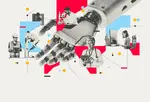Ideas
Made to
Matter
Insights for your work
From MIT Experts

Latest
Finance
Artificial Intelligence
Artificial Intelligence
Computing
Future of Work
![]()
Organizational Culture
![]()
Human Resources
![]()
Future of Work



Workforce Intelligence
Strategies to transform skills, roles, and human potential across your organization.
The Latest

Generative AI shows effectiveness in aiding weight loss
Generative AI can help people lose weight, but it can’t replace the benefits of having a community of support, research from MIT Sloan shows.
The 10 principles of finance
With technology and policy developments roiling finance, it’s a good time to revisit the fundamentals. Here are 10 core concepts from MIT Sloan Nobel laureate Robert C. Merton and co-authors.
Achieve big value with smaller AI efforts
Organizations see success by starting with smaller AI transformations. Aiming for incremental value builds a foundation for sustainable results.
Choose the human path for AI
To realize the greatest gains from artificial intelligence, we must make the future of work more human, not less.
AI hiring perpetuates familiar biases. Here’s how to avoid that trap
The AI hiring revolution doesn’t have to be a story of automated bias, argues MIT Sloan’s Emilio J. Castilla. Tough questions and constant monitoring can lead to fairer systems.
Quantum computing reality check: What business needs to know now
Commercial quantum computing is now years, rather than decades, away. It’s time for business leaders to start tracking its evolution.
10 quotes for business and management from 2025
These insights from business leaders, scholars, and scientists captured the business mood in 2025.
MIT Sloan’s top 5 ‘Working Definitions’ of 2025
The year’s most popular terms find us reassessing merit, rejiggering professional and geopolitical networks, and reevaluating how and when we bring AI into the office.
What is a data democracy, and how can your company build one?
Leaders who actively design for the widespread use of data assets generate three times the revenue from data monetization compared with their peers.
The top 10 MIT Sloan Ideas Made to Matter articles of 2025
They’re nearly all about artificial intelligence, with a guest appearance from quantum computing.














